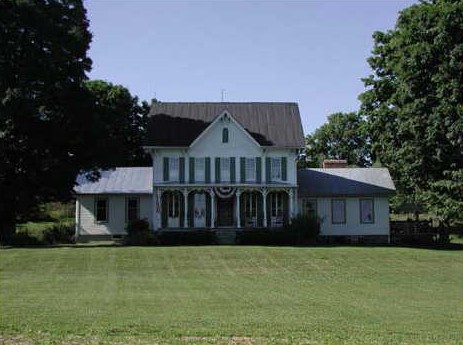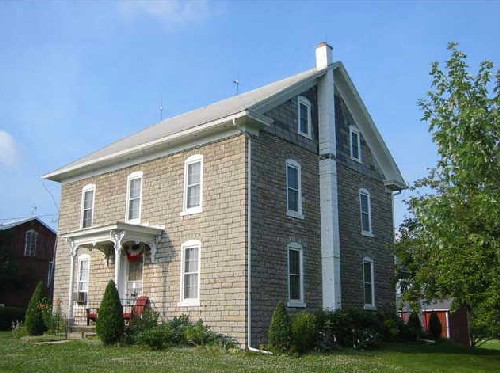House Types
Many farmhouses are not examples of any recognized architectural styles and are in fact designed according to vernacular traditions based on cultural heritage or regional preferences. Often elements of popular styles are applied to basic house forms, so that the resulting buildings have multiple influences.
Some farmhouses have undergone change over time with the addition of wings to add space and functionality and architectural details popular of the era. Others have been changed by the removal of original or historic features such as decorative porches, cornices or windows, doors and shutters.
Continental Pennsylvania German House
The "Continental plan" consists of an asymmetrical layout with a door leading to a long, narrow kitchen anchored by a large hearth. Opposite the kitchen lay a stove room and behind it a kammer or bedroom. Though its provenance is complex, this type is associated most with Pennsylvania Germans. The exterior diagnostic features include an asymmetrical facade, off-center roof-ridge chimney, and roof "kick". Variations on the three-room plan persisted through the 19th and into the 20th century in heavily Pennsylvania German regions. |  Immel house, Jackson Township, Lebanon County, 1759. Immel house, Jackson Township, Lebanon County, 1759.
|
Five-Bay House
The Five-Bay House is a common vernacular form with a central front door and symmetrical window placement. Often featuring a center hall, it is similar to the floorplan of the I-house, but on a larger scale. Five Bay Houses are often embellished with decorative stylistic elements such as a Gothic Revival style front facing gable, bracketed cornice or front porch with turned posts. |  ve-Bay House, Greenwood Township, Columbia County ve-Bay House, Greenwood Township, Columbia County
|
Four Over Four House Or PA German Double- Door FarmhouseThe Four Over Four House (also called the Pennsylvania German Double Door Farmhouse) is a vernacular house form found in areas settled by the Pennsylvania Dutch featuring a 4-bay front façade, two (or one) central side by side front doors and a side-gabled roof. These four bay houses do not have a center hall, each front door opens directly into a room. The form and floor plan show the influence of PA's sizable German (PA Dutch) population. Found only in PA and in surrounding states, the form is uniquely American - a blend of traditional German floor plans and the popular symmetrical Georgian/Federal style. The Four Over Four name refers to the four bays over four bay front façade, since the houses are usually two stories tall and two rooms deep.
|  Four Over Four house, Greenwood Township, Columbia County Four Over Four house, Greenwood Township, Columbia County
|
Foursquare House
The Foursquare House was a very popular form used throughout the country in the early 20th century. With a distinctive square cube appearance and pyramidal roof, it also featured a front porch, central front door and symmetrical window placement. Some have four dormer windows, one on each side of the roof. Foursquare houses are found in both urban and rural settings. |  Foursquare house built circa 1925, Lebanon County Foursquare house built circa 1925, Lebanon County
|
Gable Front House
The Gable Front House is a vernacular version of the Greek Revival style usually 2 stories in height with a prominent front façade gable. The front door is usually not centered on the front façade. Full width front porches or smaller entrance porticos are common on this house form. Gable Front Houses are usually 2 or 3 rooms deep. |  Gable Front house circa 1845, Richmond Township, Crawford County Gable Front house circa 1845, Richmond Township, Crawford County
|
I-House
The I-House is a vernacular house type with a central hall and door and one room on either side of the entrance. Usually three to five bays wide, one room deep and two stories in height, I-houses have side-gabled roofs. They often feature one or two-story rear additions. While common in PA and the Middle Atlantic region, the I House name comes from its prevalence in the midwestern "I" states Iowa, Indiana and Illinois. |  I-house, Cecil Township, Washington County I-house, Cecil Township, Washington County
|
New England Center Chimney House
The New England Center Chimney House form originated in the colonies north of Pennsylvania and featured a massive central chimney in the middle of the house with fireplaces opening into each room. The entrance was usually centered along the 3 or 5 bay front façades. The steep roof was designed to shed snow easily and has side gables. |  New England Center Chimney House, Log cabin built 1806, Terrytown, Bradford County. HABS photo 1936 HABS PA, 8-TERTO, 1—3 New England Center Chimney House, Log cabin built 1806, Terrytown, Bradford County. HABS photo 1936 HABS PA, 8-TERTO, 1—3
|
Single Pen House
A Single Pen House is an early house form with just one room on the first floor and having one or two stories, a side gabled roof and fireplace/chimney along the side wall. A steeply gabled roof creates a sleeping loft upstairs for single story houses. This simple house form was often the first house built on the property to provide basic shelter.
|  Single Pen House, Wertz Lashee House, Davidsburg, York County (HABS photo. HABS PA, 67-DAVBU.V, 1—1) Single Pen House, Wertz Lashee House, Davidsburg, York County (HABS photo. HABS PA, 67-DAVBU.V, 1—1)
|
Three-Bay House
The Three Bay vernacular house form has three openings on each floor of the front façade. The door is often located in the center, but is sometimes on either side, depending upon the interior floor plan. The roof usually has side gables. the Three Bay house may be one or two rooms deep. Decorative details on porches, cornices and window surrounds may reference more formal styles applied to this vernacular house type. |  Three bay house, Liberty Twp. Montour County Three bay house, Liberty Twp. Montour County
|
Upright and Wing House or Gable Front and Wing
The Upright and Wing House (also called Gable Front and Wing) is defined by its traditional form consisting of a two-story front facing gable main block with a two-story wing. The entrance is usually located in the wing portion of the house which is covered by a front porch. This house form is also found in both rural and urban settings. |  Upright and Wing house, Francis Williams House, Washington County Upright and Wing house, Francis Williams House, Washington County
|